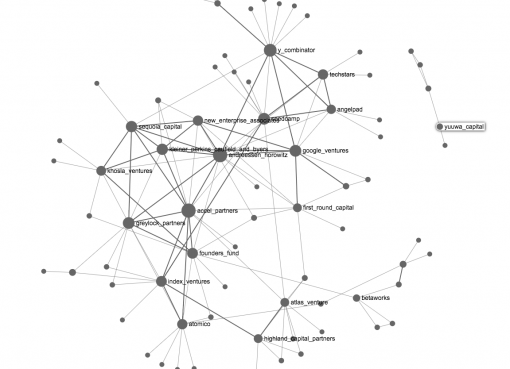Posted by Nodus Labs | March 22, 2015
Memory Enhancement: from Bullet Lists to Network Graphs

Consider a simple example: we want to keep track of the venture funds and startup seed accelerators. How to organize this information in a way that we could always retrieve it and share it with others?
The traditional approach – go to some site, like TechCrunch, choose the most interesting ones, and make a bullet list (save it in Evernote after):
• Y Combinator
• Sequoia
• Founders Fund
• Andreessen Horowitz
• Google Ventures
• Founders Fund
• Index Ventures
• Techstars
• Angelpad
• First Round Capital
• betaworks
• Atlas Ventures
This is a good list, but it lacks context. Something that lacks context lacks meaning.
Usually this issue is addressed by adding categories, but this is a very hard thing to do with most things today, especially with funds, which work through diversification (so in fact a good fund should be uncategorizable).
Another approach – make a network graph.
Just looking at this picture already gives us a good idea of who is who in the industry and makes it much easier to remember the main players. It has a lot to do with memory effects such as priming (it’s easier to remember things when they are related) and pattern recognition embedded in human perception.
The graph was retrieved using InfraNodus: it finds the entities that people search for together and visualizes them in the graph. Some connections were manually added if the funds co-invested in the same company.
The nodes in the graph were then aligned using iterative Force Atlas algorithm: the most connected nodes are pushed apart from each other, while the nodes connected to them are pulled closer. The more connections the nodes have, the bigger they are in the graph.
The resulting graph lists the funds, and provides two additional benefits: context and relevant importance of each item.
The context is produced through the connections between the nodes: we can easily see which funds are more often searched for (and mentioned) together, so this will indicate something about their relevant position in the world of venture capitalism.
The relevant importance is produced through the number of connections that each fund (node) has in the network. The more connections, the bigger it is. The more the node is connected to the most connected nodes in the network, the more central it’s going to be.
Thus, we see that all the most known funds, such as Sequoia, Andreessen Horowitz, Google Ventures have a high relevance and are centrally located, so they kind of shape the core of the venture capital market.
Then we have a bunch of funds that are still central, but a bit on the side, such as Y Combinator, Techstars, Angelpad, and Seedcamp. Those have a preference for seed investments and are different from the big ones like Sequoia. However, Y Combinator, for instance, sometimes also does bigger investments, so it’s closer to the main bunch.
Finally, there are some funds at the periphery, such as Atomico, Atlas Ventures, betaworks, Horizon Ventures as well as Yuuwa Capital and Sparkbox ventures. Those funds are less known but they can be interesting either because of their unique geographic position or a more specialized portfolio.
As we can see, a picture is worth about 480 words (so far), which is already a good result.
An interactive picture can be even more interesting. Click on the nodes in the graph below to see how the funds are connected specifically and which companies they funded. Click at the top right corner to show/hide text.


